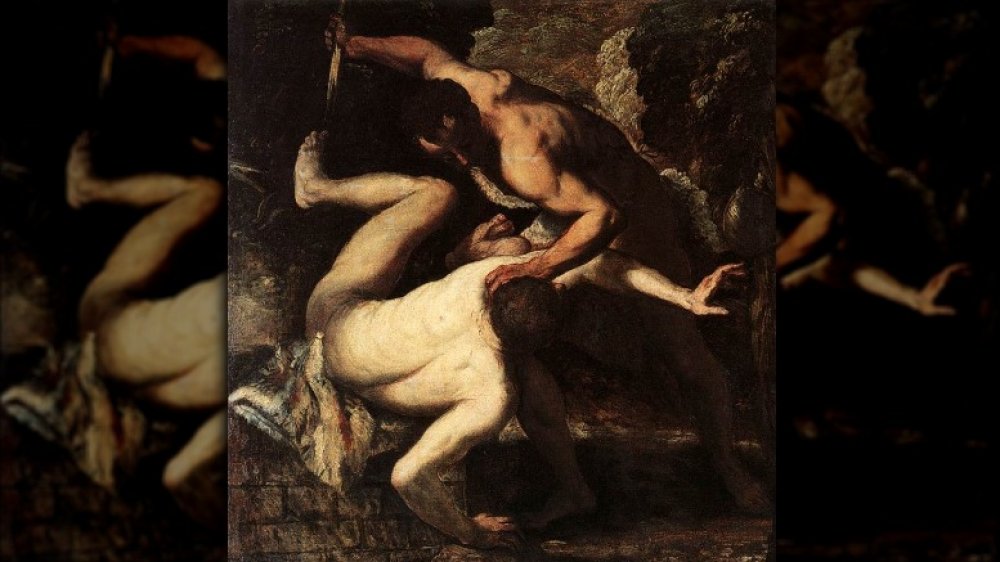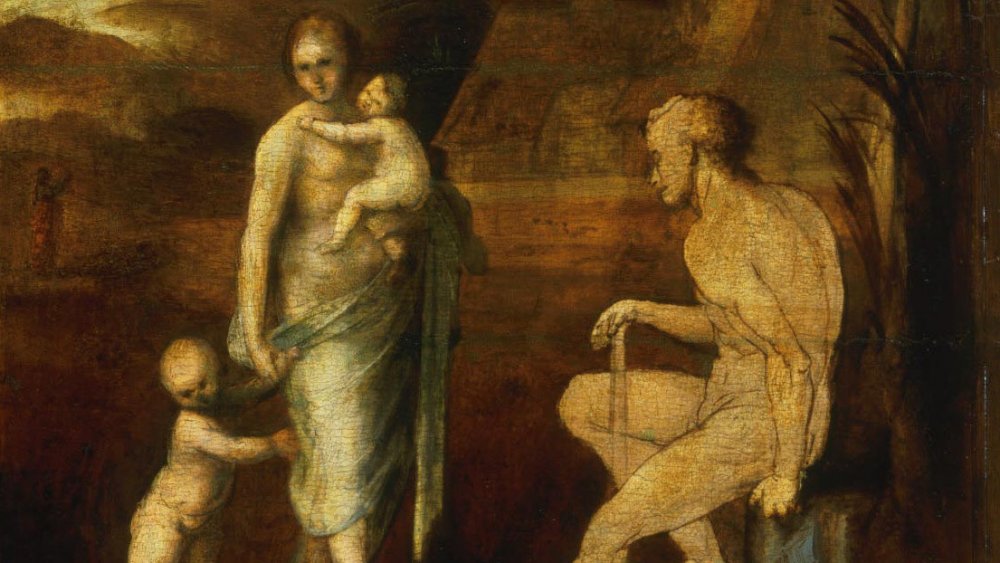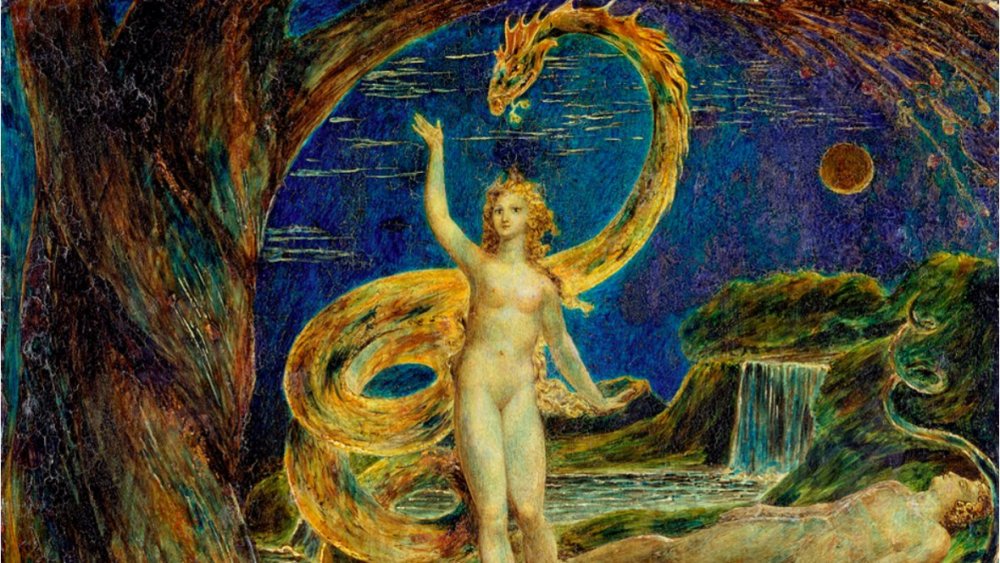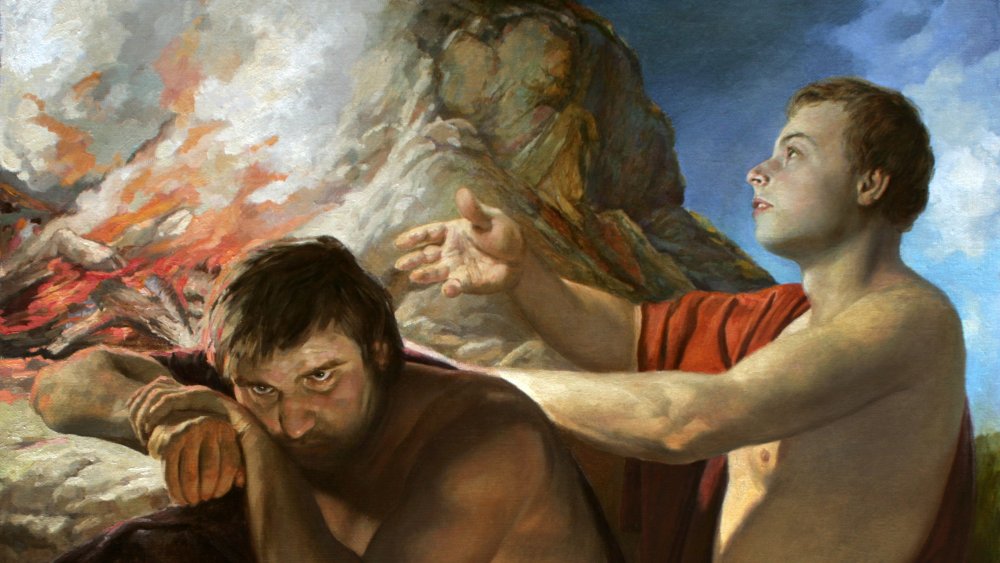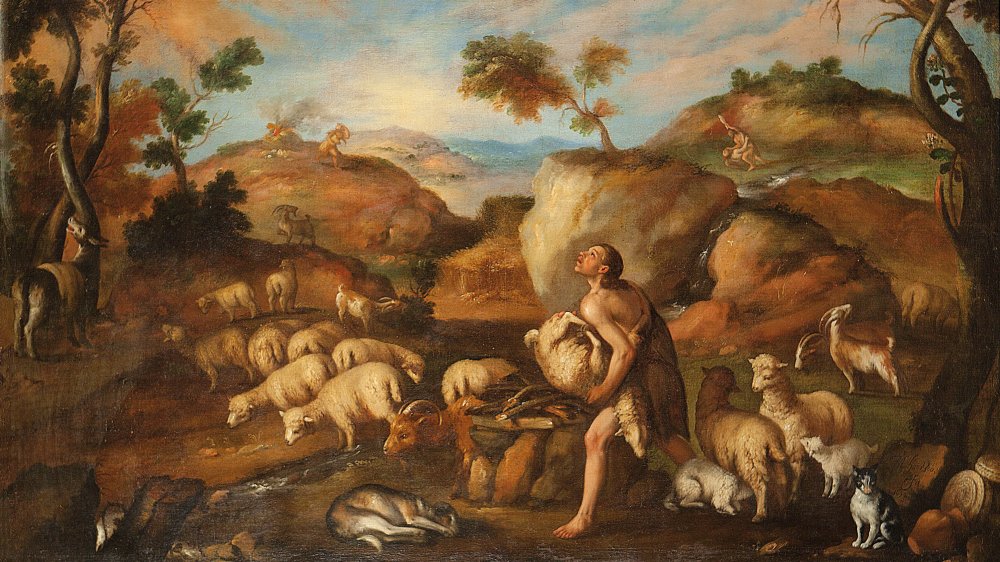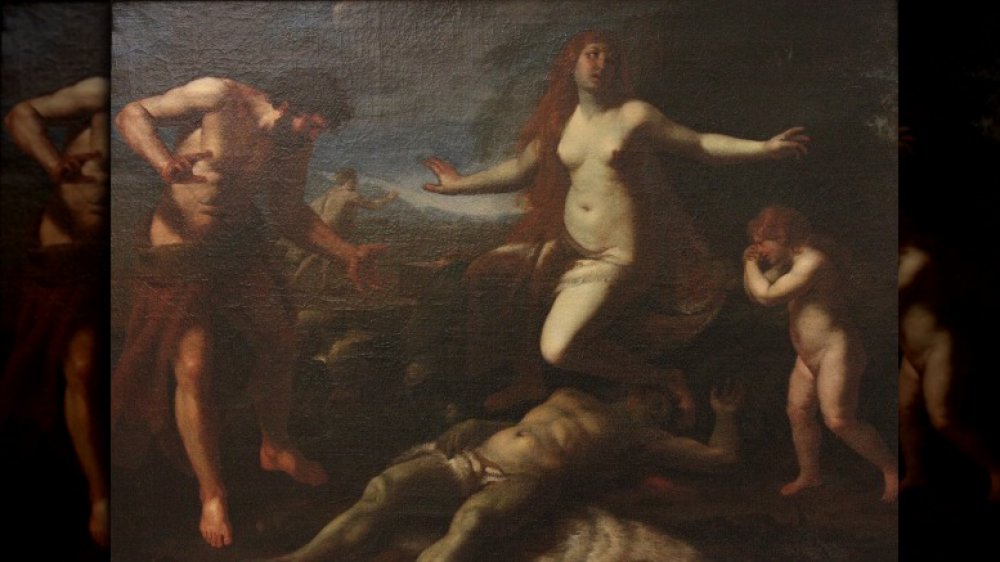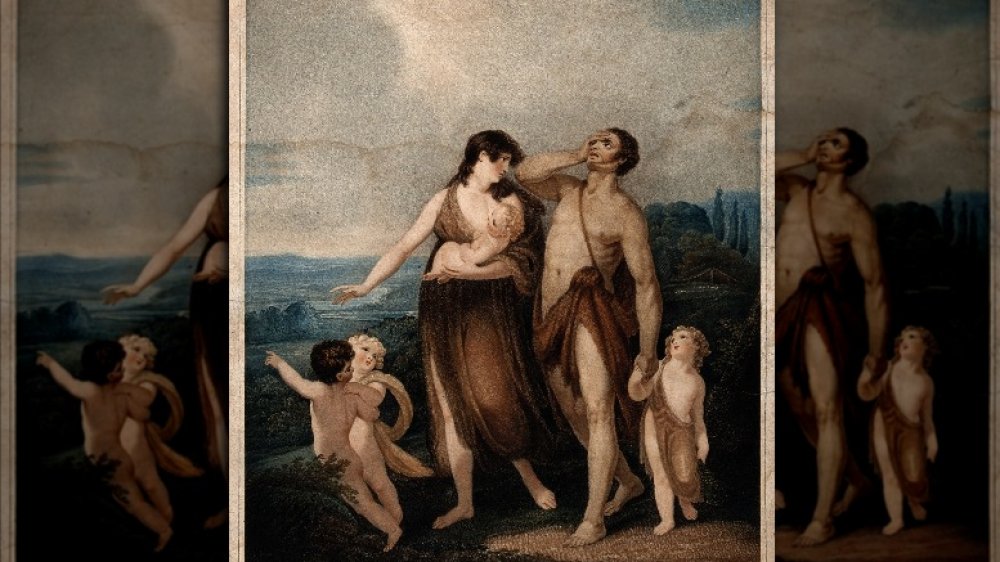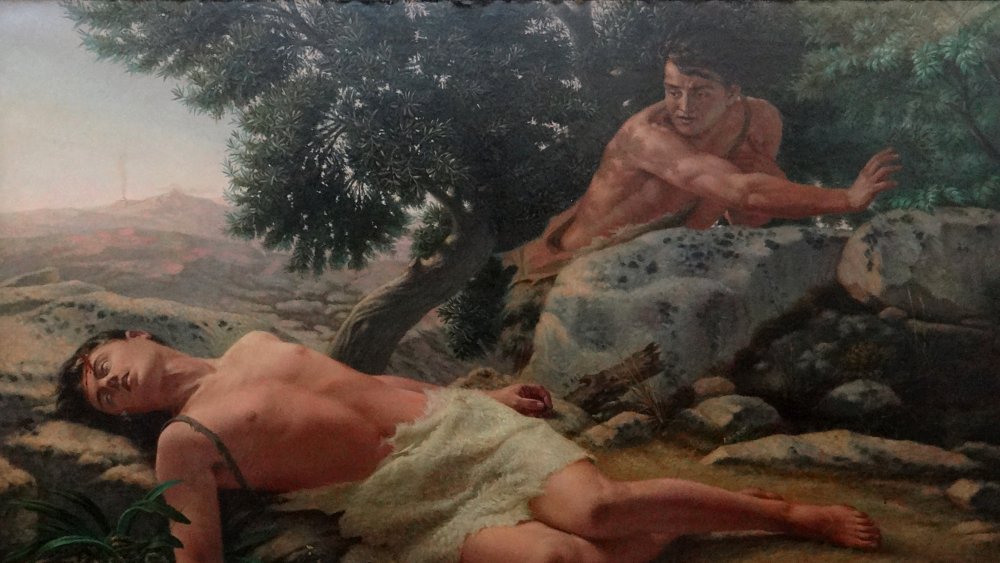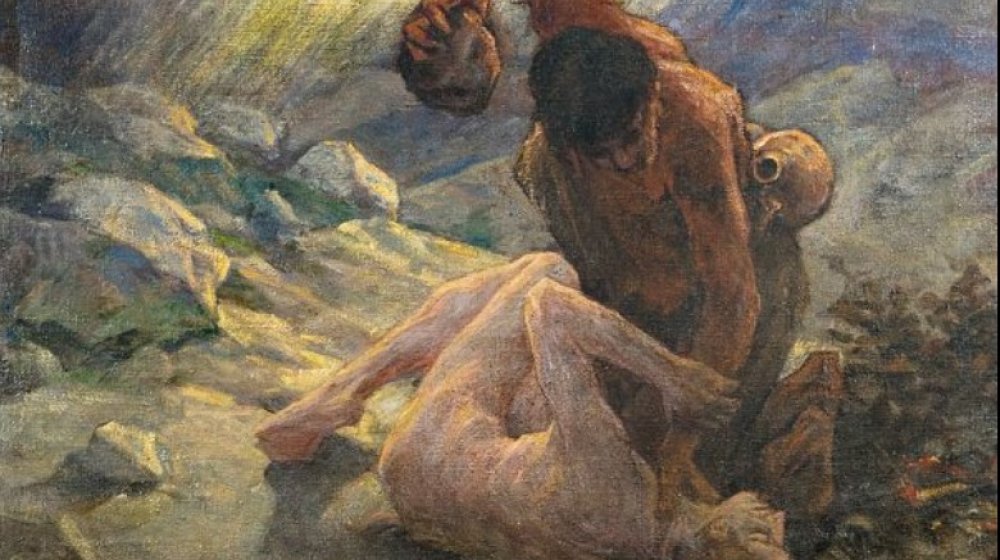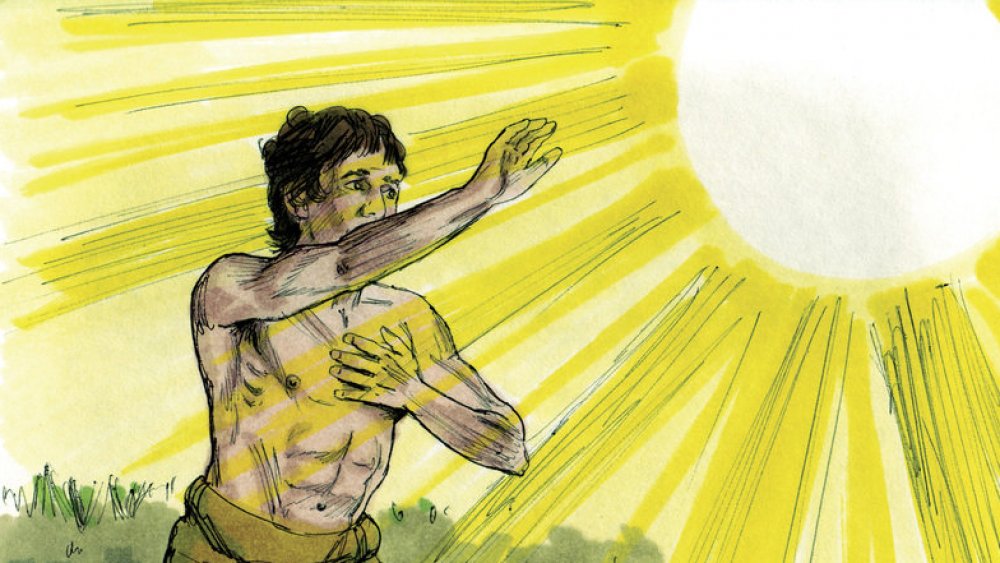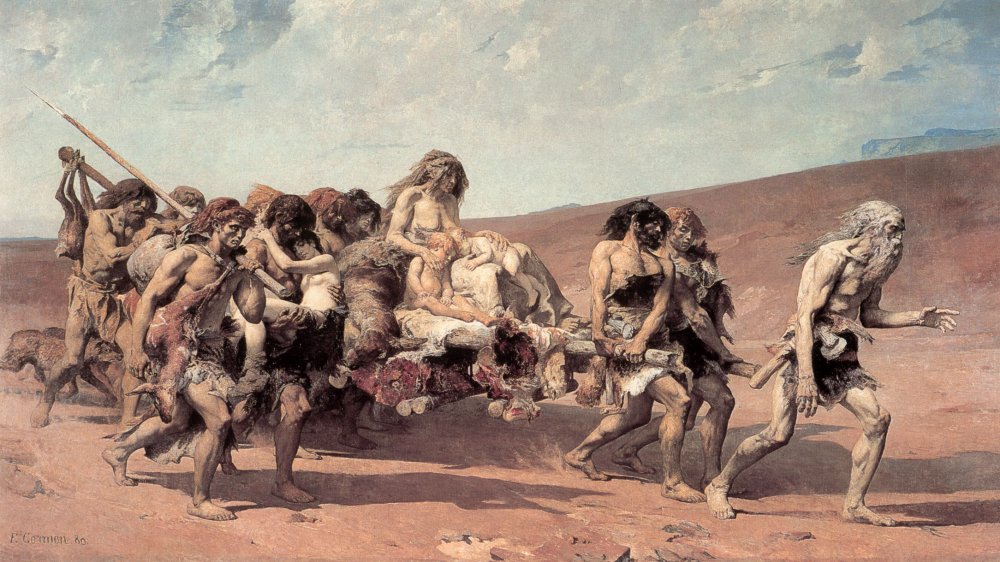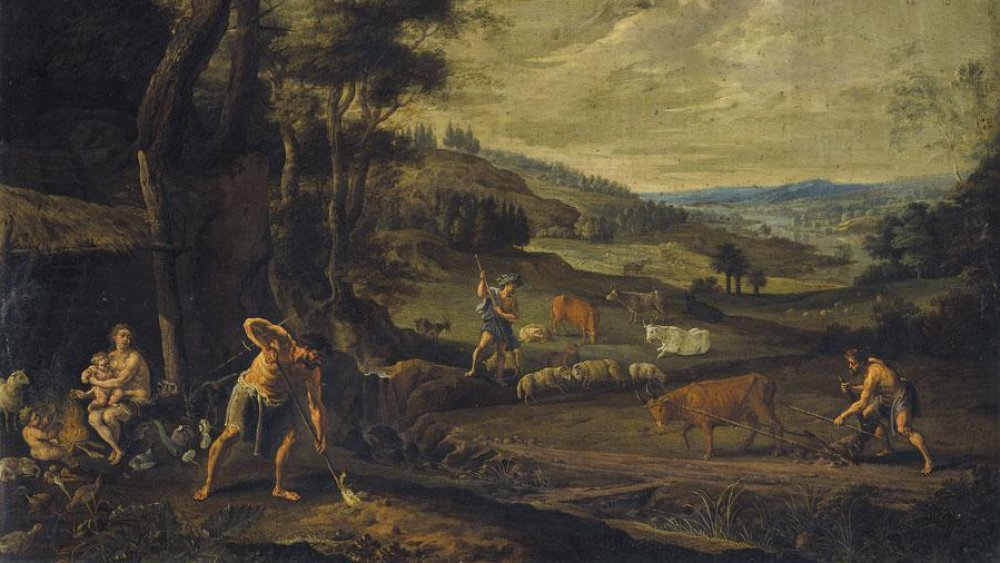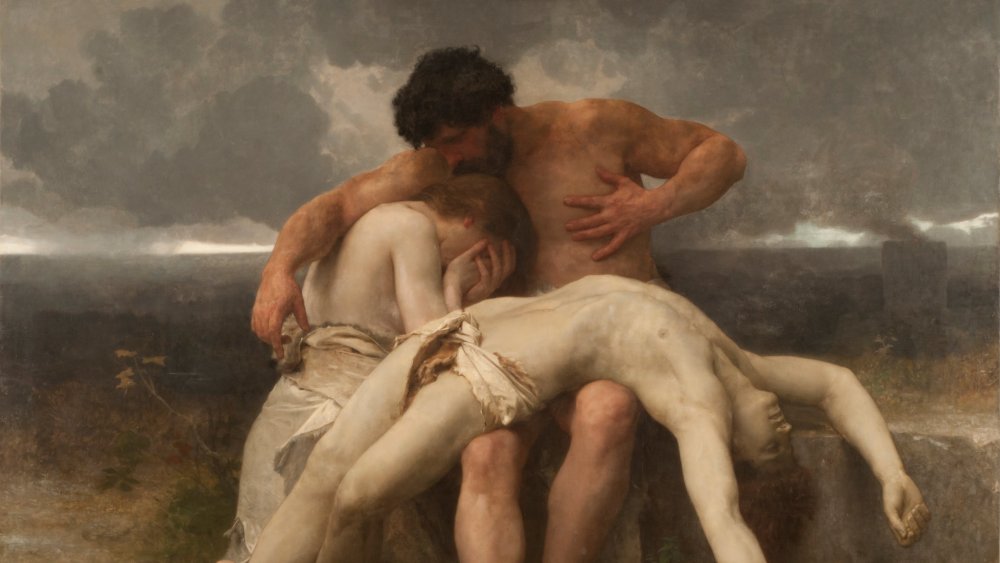What Nobody Told You About Cain And Abel
According to the Bible, Cain and Abel were the first humans born in the traditional way, rather than being molded out of dirt and ribs like their parents. They also mark a couple of other notable firsts: the first person to die and the first person to murder. The Bible tells us Cain and Abel both made offerings to God and God liked Abel's and hated Cain's, so Cain took Abel into a field and killed him.
That's pretty much it as far as details go. If you wonder why Cain killed Abel, or how, the book of Genesis doesn't provide that information. If you wonder what Cain's punishment was or how he managed to have enough kids to populate a city, the Bible's going to leave you with no satisfaction. But don't worry, there are answers to be found. Here's what no one told you about history's first murder.
Cain and Abel's names are technically spoilers
A lot of biblical names, especially those from Genesis, have an element of wordplay about them that often serves to underscore an individual figure's role in the story they feature in. Notably, the name Adam means man, because he was the first man, and Eve comes from a word meaning life, because she is the source of life for all humanity. The names of Adam and Eve's first two children, Cain and Abel, are no exceptions to this trend. It's just a little harder to identify exactly what those names are getting at. In Genesis, it says Cain's name (more like "Kayan" in Hebrew) comes from the word kanah, meaning "to get," because Eve got a baby from God. Abel (more like "Hevel" in Hebrew) gets his name from a root meaning "breath," and indicates something that doesn't last long (spoilers: Abel dies young).
However, these traditional understandings of the sources of the names Cain and Abel may not be the whole story. Rabbi David Zaslow argues Cain's name reflects another possible meaning of kanah, namely "to build," as Cain goes on to build a city, among other things. As a builder and creator, his name is related to a word meaning "smith" (as in metalworker). Meanwhile, Abel may ultimately come from a Sumerian word meaning "son." So their names indicate their roles: one son who works with his hands, and one born to die.
Cain, the original Son of Satan
Cain, the first murderer in history, is often held up as an example of the worst humanity has to offer. In fact, in the apocryphal Book of Bartholomew, when the ghost of Jesus descends into Hell to rescue all of the dead and take them up to Heaven on the day after his resurrection, the only three people who are so bad that they get left down there are Judas, Herod, and Cain. According to Jewish legend, being bad might just have been in Cain's DNA. The story claims Cain isn't Adam's son at all, but Satan's.
Louis Ginzberg's The Legends of the Jews relates that the angel Samael, who is the great Satan, appeared to Eve after she and Adam had been expelled from the Garden of Eden. He came in the form of the serpent, and ... well, you know the kind of things the world's second human (or third, if you count Adam's first wife, Lilith) and a fallen angel in snake form get up to. Nine months later, she gave birth in a delivery so painful that when Adam heard her screams, he thought Satan was after her again. Twelve angels, including the archangel Michael, had to be called in to hold Eve down. She gave birth to a glowing baby who immediately stood up, ran away, and came back with a stalk of straw for his mom.
Why God favored Abel over Cain
The big story about Cain and Abel is that the two boys each made their own individual sacrifices to God and God liked Abel's and not Cain's, so Cain killed Abel. But one of the biggest unresolved questions around this incident is why Cain's offering was rejected while Abel's was accepted. The most obvious difference between the two sacrifices is that Cain, a farmer, offered up the fruits of the field, while Abel, a herdsman, offered up the firstborn of his flock. As a result, the easy conclusion to jump to is God liked Abel's blood sacrifice and didn't like Cain's grain offering. It may not, however, be so simple. Rabbi David Zaslow points out there was no hierarchy of offerings in Temple Judaism, and the intent of the offerer was more important than the value of the offering.
According to the Jewish Encyclopedia, rabbinical literature suggests Cain's error was in offering worthless portions of his crops, and keeping the best parts for himself in greed, while Abel offered his first and best. Likewise, Bible.org notes God did not disregard Cain's offering itself, but rather "Cain and his offering," indicating that the problem was with the attitude with which Cain brought his fruits to God. The priestly guidelines in the Bible for making an offering would support the idea that an attitude of faith and supplication is an essential ingredient.
Cain and Abel might actually be secretly about farming
While many modern religious denominations interpret the Bible as a literal account of history, going all the way back to the creation of Adam and Eve in the Garden, not everyone is convinced. Even people who fully believe in the existence of God and his covenant with Abraham and other elements from Genesis might choose to interpret the first 11 chapters or so (the Creation and Fall and then Noah and the Tower of Babel and basically everything before the introduction of Abraham) as being an allegory for human history rather than literal fact.
If this is the case, the understanding of the story of Cain and Abel becomes a little clearer. As Rabbi David Zaslow points out, Cain the farmer and Abel the shepherd represent the two main types of economies in the Fertile Crescent at that time: farming and herding. The Jewish people, who spent a large portion of their history as sojourning herdsmen surrounded by agrarian cultures trying to kill them, might have a natural affinity for one side over the other. Likewise, Cain's attempts at controlling nature through human invention–agriculture, building, and so on–represents something of a hubristic affront to God's natural creation, which the guileless Abel accepts as is. And if absolutely nothing else, the book of Genesis has a recurring motif of younger brothers besting their older brothers, both for good and ill.
Eve's terrifying dream
Someone trying to escape their destiny and consequently fulfilling that very destiny is a common motif in ancient literature. For example, in Sophocles' Oedipus Rex, it is the constant struggle to escape the prophecy that the infant Oedipus will grow up to kill his father and marry his mother that literally leads to him, well, killing his father and marrying his mother (spoilers for a 2,500-year-old play). The tragedy of Cain murdering his brother Abel is no exception, at least if you're willing to believe texts from outside of the main biblical canon.
According to an apocryphal Jewish text from about the first century CE known as The Life of Adam and Eve, after the birth of Abel, Eve awoke one night after a disturbing dream. In the dream she had seen Cain with blood on his hands, blood that turned out to be his brother Abel's. What's worse is that Cain was drinking Abel's blood, just slamming it down like can after can of Mountain Dew Code Red. Eve was so horrified by this dream that she told Adam about it. Trusting Eve's dream was indeed a premonition, Adam made the helpful suggestion the best way to keep one brother from chugging the other's life juice was to keep them apart. What if one was raised to be a farmer and the other one raised to be a shepherd? Whoops.
Cain and Abel weren't the only children of Adam
A common question that arises after someone hears the biblical account of Creation is how do you populate a whole world with only four people when three of them are men, all of them are related, and one of them is dead? Well, even if we only look at canonical sources, we know Adam and Eve had another child after the death of Abel, whom they named Seth. As the Jewish Encyclopedia explains, Seth is the son through whom the family line of Adam continues on to Noah and then David, and then ultimately the Messiah, which was Jesus if you're Christian, and not Jesus if you're not Christian. As Seth was the natural counterpoint to his brother Cain, he becomes a symbol of good in the way that Cain came to represent evil. Seth would ultimately become the figurehead of a line of Christian sects known as the Sethian Gnostics, who viewed Adam's third son as the "mediator of divine wisdom to mankind."
But if your question continues, "Okay, but were there any girls? You kind of need them." According to Chabad, rabbis teach that Cain was born with a twin sister and Abel was born a triple with two sisters whom the Bible simply neglects to mention. Each brother was intended to marry his twin. This might strike you as icky, but God granted them special dispensation.
Why did Cain kill Abel?
As any true crime fan knows, in order to prove someone's guilt in a crime as serious as murder, you have to be able to establish means, motive, and opportunity; that is to say how and why such a crime might be committed. In the case of Cain and Abel, the motive might seem obvious: namely, Cain was jealous God accepted Abel's offering and rejected his own and killed his brother out of anger. However, the biblical account in Genesis doesn't ever state that explicitly, and so there have been a number of interpretations over the years.
As the author Elie Wiesel recounted, rabbinical literature supplies a number of other motivations behind Cain's violent act outside of the incident of the offerings. According to these sources, Cain and Abel divided their inheritance from Adam such that Cain got the land and Abel got everything else, sparking jealousy. Or they were both attracted to their mother, Eve, and fought over her attentions. More commonly, Cain felt that the twin sister Abel was meant to marry was more attractive than his own betrothed, or else they fought over who would get to marry the spare third sister. Alternatively, they argued over whose domain would house the eventual Temple. The Talmud suggests Abel showed no sympathy for Cain's dejection at being snubbed by God and sparked his anger that way. So, you know, pick your fave.
How did Cain kill Abel?
If the motive behind Cain's murder of Abel is agreed to be jealousy–whether over a woman, land, or God's favor–the question that arises next pertains to the means of death. Did Cain slay Abel in the conservatory with the candlestick? The book of Genesis gives no details, stating merely that Cain "rose up against his brother Abel and killed him."
Fortunately, as ever, apocryphal literature rises up to fill the gaps and, as Notre Dame's Medieval Studies Research Blog tells us, common explanations for Cain's method of murder include suffocating Abel and then sawing his head off with a donkey's jawbone, slashing him with a farm implement, chewing Abel's head off with his own teeth, or simply punching him in the head until he died. The jawbone one is most common, though.
The Jewish text the Book of Jubilees, however, which is canonical in the Ethiopian Orthodox Church, goes for a simpler explanation: Cain whacked Abel over the head with a rock. Simple, clean, believable, and less grotesque than sawing off a head with donkey teeth. What's more, Jubilees takes this opportunity to expend some poetic justice on Cain. Cain's death comes when his house crumbles and crushes him with the stones of its walls, just as he crushed his brother. It is, after all, like they say: he who lives by the stone will die by the stone.
The secret of the Mark of Cain
While Abel's story understandably ends with his death, and he is never mentioned again in the Hebrew scriptures after Genesis chapter 4, we do get some information on what happens to Cain after killing his brother. In verse 11, God curses Cain to a life of fruitless toil and wandering. Cain worries anyone he encounters will try to kill him (perhaps a weird thing to worry about if the only other two people on Earth are his mom and dad), so God marks Cain so anyone who harms him will suffer sevenfold vengeance.
The meaning of the Mark of Cain is ambiguous (it may even just be a sign God showed him), and Cain's mark and his curse have often been conflated. Bible Odyssey explains that interpretations include that Cain was given leprosy, or his forehead sprouted a horn (which ultimately led to Cain's death when his son confused him with a wild animal), or the sacred name of God was inscribed on his arm or forehead as a protective sigil. Others suggest maybe God just gave him a dog as protection, which might also have been seen as a curse, as there are no positive references to dogs in the Hebrew Bible. The worst explanation is the Mark of Cain was dark skin, an idea used as a justification for slavery and racism well into the 20th century.
Wandering in the Land of Nod
The book of Genesis tells us that after God cursed Cain, Cain left the presence of the Lord and ended up in a place east of the Garden of Eden called Nod, which means "wandering." Once there he builds a city, presumably the world's first, and that is the last we hear of Cain in biblical canon. However, the Jewish historian Josephus, in his work Antiquities, expands somewhat on the further adventures of the world's first murderer. Rather than repent of his great crime and turn to a life of peace after having been spared God's wrath, Cain doubles down on his wickedness and becomes something of an innovator in the world of evil.
Josephus states Cain dedicated himself to the pursuit of pleasure and wealth at any cost, including perpetrating theft and violence upon his neighbors. He built up a great amount of wealth through stealing and strong-arming, and encouraged his friends to do the same, thereby building up a huge army of terrible dudes led by Cain himself. Cain is also credited with creating weights and measures, which seems like it might be a positive thing, but Cain used the idea to make sure no one was accidentally being generous by innocently giving too much. He likewise invented the idea of property lines and drawing up fortifications to protect one's belongings with violence.
Who was Cain's wife? No, seriously
Genesis tells us Cain had a wife, and the two of them had a son named Enoch (not the more famous Enoch who God brought up to Heaven so they could have a chill hang), after whom Cain named his great city. This raises something of an obvious question: uh, who was Cain's wife? Literally all the Bible says is she and Cain did the deed and had a baby. Ancient Origins points out that some believe God had created more people who were not born of Adam and Eve and Cain encountered these people in Nod, but Bible Study Tools counters that Cain's wife had to be one of the other sons and daughters of Adam and Eve mentioned in Genesis chapter 5. Some sources, including the Book of Jubilees, say Cain's wife was his sister Awan, while Abel's wife was their sister Azura, who would marry Seth after Abel's murder.
The descendants of Cain were known for their wickedness just like their father. Josephus says that even within Adam's lifetime the lineage of Cain had become a corrupt mess, with each new generation more evil than the last. But they are also credited with some significant innovations as well. Cain's descendant Lamech (not to be confused with Noah's father) invented polygamy, while later Jubal invented music, including the lyre and the pipe. Tubal-Cain invented metalworking and was skilled in warfare.
The ghost of Abel cries out for vengeance from the pit of the dead
While Abel never appears in the Hebrew scriptures again after his death in Genesis chapter 4, he is mentioned a couple of times in the New Testament. In the Gospel of Matthew chapter 23, Jesus compares himself to Abel, whom he names as the first martyr, whose righteous blood would be upon the head of all the hypocrites persecuting Jesus. The Epistle to the Hebrews, meanwhile, contrasts the blood of Jesus and the blood of Abel, with Jesus' death bringing mercy, while Abel's blood cried out for vengeance from the earth on which it was spilled. The role of the first martyr who cries out for justice and retribution is later applied to Abel in the Jewish text The Book of Enoch (about the good Enoch, not the bad one), which, like Jubilees, is canonical for the Ethiopian Orthodox Church.
In Enoch chapter 22, our title character is taken on a tour of the afterlife. After having been introduced to the archangels and shown the ultimate fate of the fallen angels, who were affixed to the heavens as stars, Enoch is shown the Underworld, which is divided into four smooth pits representing four kinds of people: the righteous who prospered, the righteous who suffered, the wicked who prospered, and the wicked who suffered. Abel is named as the chief spirit among the martyrs, crying out for vengeance against the seed of Cain.
